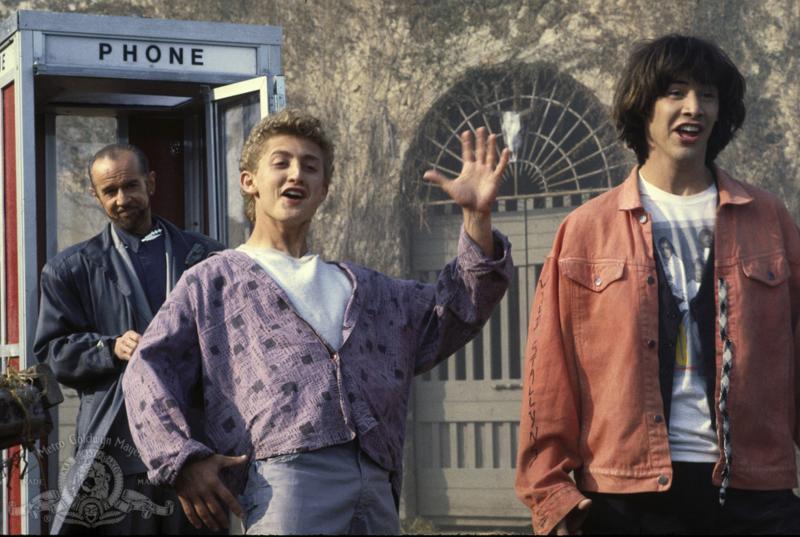Taking a look at Keanu Reeves films
There have been a ton of Keanu Reeves-centric memes through the years. Even after having endured decades of cinematic success, he is still known for keeping a rather low-key personal profile. Countless memes have been crafted using his visage, including “Sad Keanu,” “Conspiracy Keanu,” “Tai Chi Keanu,” and “Happy Keanu.”
Additionally, there have been analyses of all the films in which he plays a character named John (it’s nine, starting with Johnny Utah in 1987’s “Point Break”), and the number of times he utters “Whoa” in his films (it’s 108 as of 2016, but with another “Bill & Ted” film, that number is sure to rise).
His career has spanned films from indelible to regrettable, but he still manages to pique curiosity with each project he is involved in.
To celebrate the release of his latest film, “John Wick: Chapter 3,” I was looking over the actor’s career and uncovered yet another item to add to the Reeves mythology, which I will call “Keanu’s Third Law of Cinematic Motion.” With apologies to Newton, it roughly states: “For every Keanu Reeves hit, there is a film in his filmography that is both equal and opposite.”
This article will offer irrefutable evidence to back up this theory, so please indulge me as I explain my cinematic claim of Keanu Force Pairs:
Devil’s Advocate: This 1997 film has Keanu square off with the Devil, featuring Al Pacino at his Pacino-est in this trashy-fun slide into decadence.
Constantine: Reeve’s next dance with the devil was not as pretty. In 2005, he starred as an underworld detective and battled Lucifer once again (this time played by Peter Stormare), but failed to ignite a cinematic inferno.
My Own Private Idaho: Reeves starred alongside River Phoenix for this gritty tale of street hustlers, under the direction of Gus Van Sandt working at his prime.
Even Cowgirls Get the Blues: When Reeves and Van Sandt collaborated just two years later in this mess, the results were not as rewarding. Only the director’s decision to film a shot-by-shot remake of “Psycho” saved this film from the bottom of his resume.
The Man of Tai Chi: Reeves makes his directorial debut in this underseen 2013 release about an underground fight club. The film is rather straightforward narratively, but is always engaging, energetic and filled with great fighting scenes and old-school charm.
47 Ronin: That same year (2013) saw the release of this much-larger-budgeted 3D film set in medieval Japan that cast Reeves as a half-Japanese, half-English samurai who led a group avenging the death of their lord.
Speed: Often considered one of the actor’s best films, this still-effective thriller cast Reeves as an LAPD officer who must stop a madman (played by Dennis Hopper) from blowing up a bus carrying a group of civilians.
Street Kings: Reeves once again returns to the LAPD, but this time working in vice and reeling from the death of his wife as he tracks down members of a Korean street gang. “Kings” fails to contain any of the velocity of “Speed” and stalls before it gets out of the parking garage.
Parenthood: Reeves was but a young lad in Ron Howard’s ensemble comedy in which he plays the stoner, goal-less boyfriend of Martha Plimpton. Reeves’ slacker seemed to exist solely to infuriate the family patriarch, played by Steve Martin.
The Price of Pennsylvania: Playing almost exactly the same character (right down to the unevenly shaved hairdo), Reeves’ enthusiastic layabout in this film had a little more nefarious intention for the father (kidnapping him and holding him for ransom), but this no-budget film (released in the same year as “Parenthood”) had none of the gloss of Howard’s offering.
Bill & Ted’s Excellent Adventure: Another one of Keanu’s iconic screen creations, Ted “Theodore” Logan had endured through two sequels (the second to be released next year) and an animated series. His time-traveling exploits with his best buddy have led to countless wacky excursions with notable historical figures.
The Lake House: When Keanu traveled through time for romantic purposes, though, in this 2006 film reuniting him with “Speed” lead Sandra Bullock, the results were far from “Excellent” and closer to “Bogus.”
The Matrix: Another enduring screen character that altered the landscape of science fiction films, “The Matrix” remains stylistically groundbreaking and still a thrill to watch (even though they blew it on the sequels).
Johnny Mnemonic: Just four years prior to “The Matrix,” Reeves starred in this cyberpunk sci-fi tale as a young man who has computerized information implanted in his brain. This film covers quite similar themes ... but replace all the cool, groundbreaking stuff with a wig-wearing Dolph Lundgren, “futuristic” technology that resembles early Nintendo, and a cybernetic dolphin as the film’s mastermind.
River’s Edge: A group of misfit high schoolers witness a shocking act of violence and proceed to cover it up by various means that only further complicate their lives. One of Reeves’ earliest roles, and one that earned him early accolades.
Brotherhood of Justice: A group of misfit high schoolers witness shocking acts of violence and proceed to put an end to them through vigilante means that only further complicate the script. Released the same year as “River’s Edge,” this TV movie did nothing for his career (or the careers of co-stars Kiefer Sutherland, Lori Loughlin, or Billy Zane).
















































